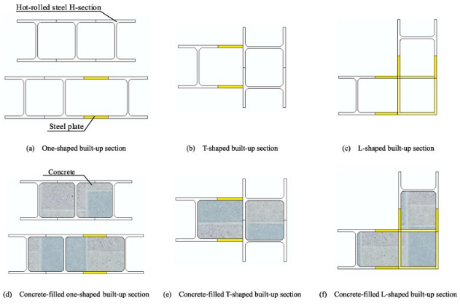[Structural Engineering]
Tan, Ji-Ke; Wang, Yu-Hang; Su, Mei-Ni; Zhang, Hai-Bin; Peng, Yuan-Yuan. Compressive behaviour of built up hot-rolled steel hollow and composite sections[J]. Engineering Structures, 2019,198:109528.
Keywords: Built-up sections; Compression bearing capacity; Concrete-filled built-up section tube; H-section; Numerical modelling; Design methods
High Lights:
Experiment and numerical analysis of built-up hot-rolled steel sections were carried out.
The design rules for hot-rolled built-up section stub columns under compression were proposed.
The design rules of the stability bearing capacity of columns have been developed.
Abstract:
In this paper, a new type of steel section is proposed comprising adjacent H-sections linked together by intermediate steel plates welded along their flanges. Experiments on three hot-rolled steel built-up H-sections and five columns infilled with concrete are conducted, with results showing that both variants having much better ductility compared to conventional columns (i.e. hollow section columns and concrete filled steel tube (CFST) columns). Experimental results showed that the bearing capacity of the built-up hot-rolled steel hollow section column improved by 45.1% to 55% after it was filled with concrete. A finite element software ABAQUS is used for parametric study. The newly developed finite element models were validated against test results in terms of failure modes and load-displacement curves. A total of 482 numerical results, 132 hot-rolled steel built-up section columns and 350 concrete-filled built-up section columns, have been generated. Based on the experimental and numerical results, the compressive behaviours of hot-rolled steel built-up section columns and concrete-filled built-up section columns are studied. A new design method for the compression capacity of these two types of columns is proposed. It is found that the newly proposed design method could provide accurate and consistent predictions - the mean value of experimental to predicted results are 0.963 for hollow section columns (with coefficient of variation being 0.061) and 1.04 for composite section columns (with coefficient of variation being 0.043).
Resource:
https://www.sciencedirect.com/science/article/pii/S0141029619323582?via%3Dihub
